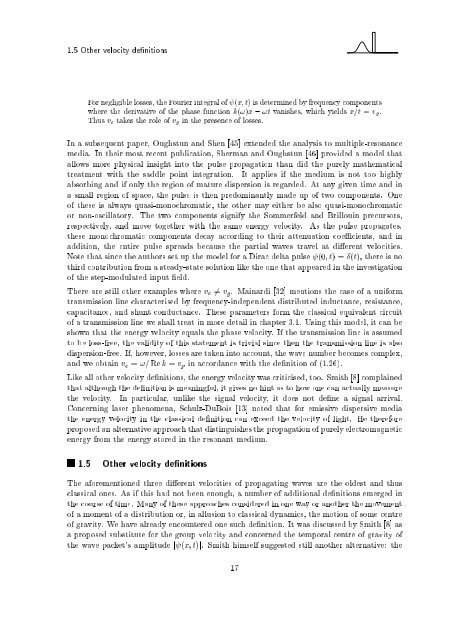Wave Propagation in Linear Media | re-examined
Wave Propagation in Linear Media | re-examined
Wave Propagation in Linear Media | re-examined
Create successful ePaper yourself
Turn your PDF publications into a flip-book with our unique Google optimized e-Paper software.
1.5 Other velocity de nitions<br />
For negligible losses, the Fourier <strong>in</strong>tegral of (x; t) is determ<strong>in</strong>ed by f<strong>re</strong>quency components<br />
whe<strong>re</strong> the derivative ofthe phase function k(!)x , !t vanishes, which yields x=t = vg.<br />
Thus ve takes the role of vg <strong>in</strong> the p<strong>re</strong>sence of losses.<br />
In a subsequent paper, Oughstun and Shen [45] extended the analysis to multiple-<strong>re</strong>sonance<br />
media. In their most <strong>re</strong>cent publication, Sherman and Oughstun [46] provided a model that<br />
allows mo<strong>re</strong> physical <strong>in</strong>sight <strong>in</strong>to the pulse propagation than did the pu<strong>re</strong>ly mathematical<br />
t<strong>re</strong>atment with the saddle po<strong>in</strong>t <strong>in</strong>tegration. It applies if the medium is not too highly<br />
absorb<strong>in</strong>g and if only the <strong>re</strong>gion of matu<strong>re</strong> dispersion is <strong>re</strong>garded. At anygiven time and <strong>in</strong><br />
a small <strong>re</strong>gion of space, the pulse is then p<strong>re</strong>dom<strong>in</strong>antly made up of two components. One<br />
of these is always quasi-monochromatic, the other may either be also quasi-monochromatic<br />
or non-oscillatory. The two components signify the Sommerfeld and Brillou<strong>in</strong> p<strong>re</strong>cursors,<br />
<strong>re</strong>spectively, and move together with the same energy velocity. As the pulse propagates,<br />
these monochromatic components decay accord<strong>in</strong>g to their attenuation coe cients, and <strong>in</strong><br />
addition, the enti<strong>re</strong> pulse sp<strong>re</strong>ads because the partial waves travel at di e<strong>re</strong>nt velocities.<br />
Note that s<strong>in</strong>ce the authors set up the model for a Dirac delta pulse (0;t)= (t), the<strong>re</strong> is no<br />
third contribution from a steady-state solution like the one that appea<strong>re</strong>d <strong>in</strong> the <strong>in</strong>vestigation<br />
of the step-modulated <strong>in</strong>put eld.<br />
The<strong>re</strong> a<strong>re</strong> still other examples whe<strong>re</strong> ve 6= vg. Ma<strong>in</strong>ardi [32] mentions the case of a uniform<br />
transmission l<strong>in</strong>e characterised by f<strong>re</strong>quency-<strong>in</strong>dependent distributed <strong>in</strong>ductance, <strong>re</strong>sistance,<br />
capacitance, and shunt conductance. These parameters form the classical equivalent circuit<br />
of a transmission l<strong>in</strong>e we shall t<strong>re</strong>at <strong>in</strong> mo<strong>re</strong> detail <strong>in</strong> chapter 3.1. Us<strong>in</strong>g this model, it can be<br />
shown that the energy velocity equals the phase velocity. If the transmission l<strong>in</strong>e is assumed<br />
to be loss-f<strong>re</strong>e, the validity of this statement is trivial s<strong>in</strong>ce then the transmission l<strong>in</strong>e is also<br />
dispersion-f<strong>re</strong>e. If, however, losses a<strong>re</strong> taken <strong>in</strong>to account, the wave number becomes complex,<br />
and we obta<strong>in</strong> ve = != Re k = vp <strong>in</strong> accordance with the de nition of (1.26).<br />
Like all other velocity de nitions, the energy velocity was criticised, too. Smith [8] compla<strong>in</strong>ed<br />
that although the de nition is mean<strong>in</strong>gful, it gives no h<strong>in</strong>t astohow one can actually measu<strong>re</strong><br />
the velocity. In particular, unlike the signal velocity, it does not de ne a signal arrival.<br />
Concern<strong>in</strong>g laser phenomena, Schulz-DuBois [13] noted that for emissive dispersive media<br />
the energy velocity <strong>in</strong> the classical de nition can exceed the velocity of light. He the<strong>re</strong>fo<strong>re</strong><br />
proposed an alternative approach that dist<strong>in</strong>guishes the propagation of pu<strong>re</strong>ly electromagnetic<br />
energy from the energy sto<strong>re</strong>d <strong>in</strong> the <strong>re</strong>sonant medium.<br />
1.5 Other velocity de nitions<br />
The afo<strong>re</strong>mentioned th<strong>re</strong>e di e<strong>re</strong>nt velocities of propagat<strong>in</strong>g waves a<strong>re</strong> the oldest and thus<br />
classical ones. As if this had not been enough, a number of additional de nitions emerged <strong>in</strong><br />
the course of time. Many of these approaches conside<strong>re</strong>d <strong>in</strong> one way or another the movement<br />
of a moment of a distribution or, <strong>in</strong> allusion to classical dynamics, the motion of some cent<strong>re</strong><br />
of gravity. We have al<strong>re</strong>ady encounte<strong>re</strong>d one such de nition. It was discussed by Smith [8] as<br />
a proposed substitute for the group velocity and concerned the temporal cent<strong>re</strong> of gravity of<br />
the wave packet's amplitude j (x; t)j. Smith himself suggested still another alternative: the<br />
17












